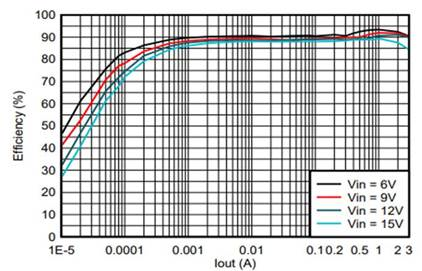SLYY231A March 2024 – March 2024 BQ25171-Q1 , BQ25622 , BQ25638 , LMQ66430-Q1 , LMR36502 , TPS37-Q1 , TPS62903-Q1 , TPSM365R15
- 1
- Overview
- At a glance
- The importance of nano-IQ in different power applications
- Achieving nano IQ in industrial BMS monitors
- Achieving nano IQ in automotive BMS monitors
- Achieving nano IQ in automotive BMS chargers
- Achieving nano IQ in voltage supervisors
- Achieving nano IQ in industrial and personal electronics DC/DC converters
- Achieving nano IQ in automotive DC/DC converters
- Conclusion
- References
- Additional resources
Achieving nano IQ in automotive DC/DC converters
There are many always-on automotive applications such as sensors, e-call systems and zone control units where long standby time and high efficiency at light loads are very crucial. The LMQ66430-Q1 buck converter is designed to overcome these challenges, achieving >85% efficiency at 1mA loads and allowing an unloaded typical current consumption of 1.5µA at 13.5VIN. The IC runs an impedance check at startup on the VOUT/FB pin. If no external feedback resistors are detected, the device will automatically use an internal feedback network that sets a fixed 3.3V or 5V output voltage, which helps minimize leakages through the feedback network and reduces IQ. The LMQ66430-Q1 uses an internal low-dropout regulator (LDO) to provide power to the internal circuitry for the IC. Rather than powering the LDO with input voltage and taking the efficiency hit, the LMQ66430-Q1 leverages the same voltage from the VOUT/FB pin to power the internal LDO, which then biases all internal circuitry in order to minimize the total IQ.
Another buck converter, the TPS62903-Q1, uses an R2D interface to set the output voltage, enabling a reduction in leakage current. The TP62903-Q1 seamlessly transitions to power-save mode as the load decreases. In this state, the IC operates in pulse-frequency modulation (PFM) mode by reducing the switching frequency to maintain high efficiency, as shown in Figure 6 under light-load conditions. This reduces the typical IQ to 4µA.
 Figure 6 Efficiency versus output
current (3.3VOUT at 2.5MHz, 1μH, automatic PFM or pulse-width
modulation).
Figure 6 Efficiency versus output
current (3.3VOUT at 2.5MHz, 1μH, automatic PFM or pulse-width
modulation).